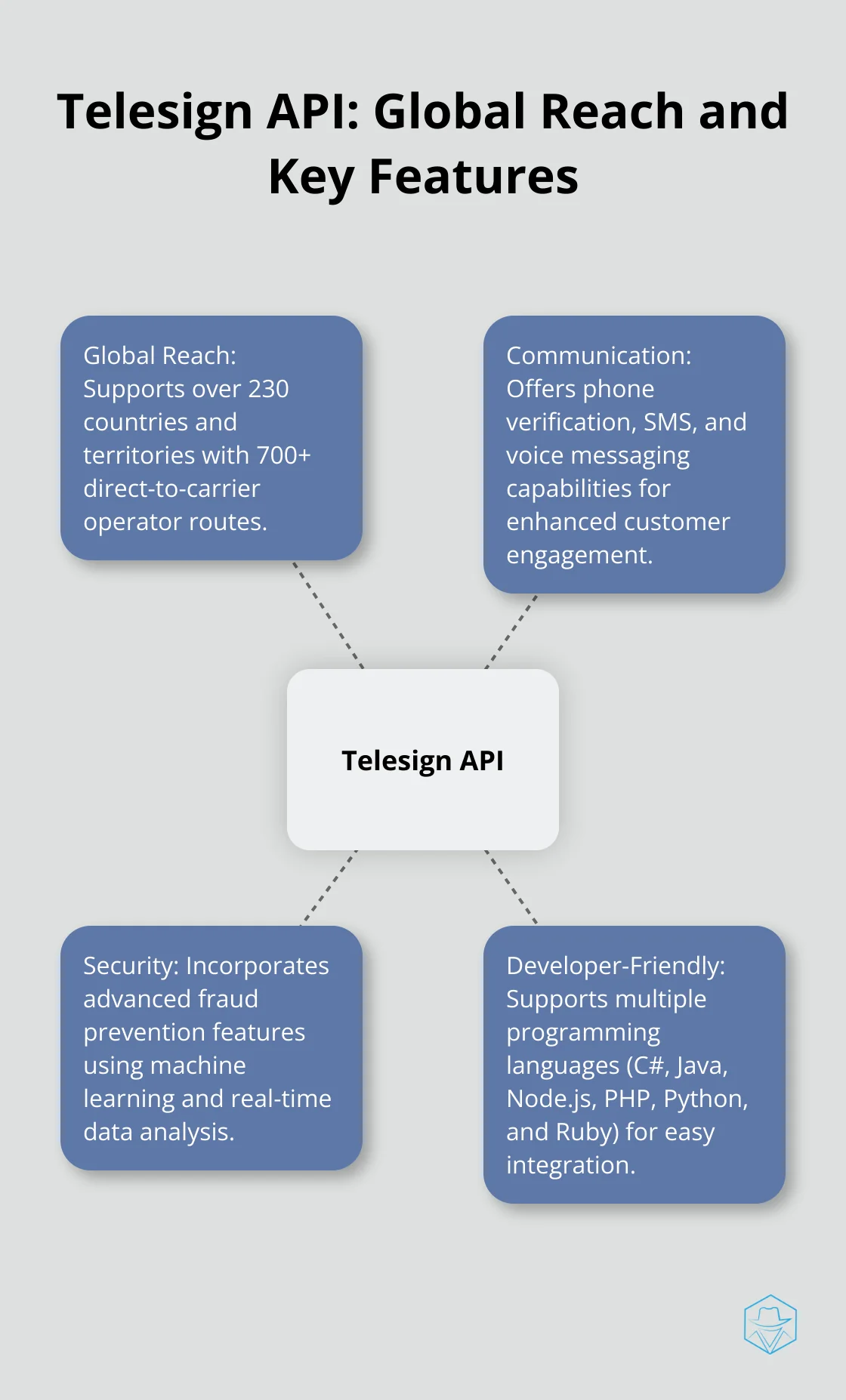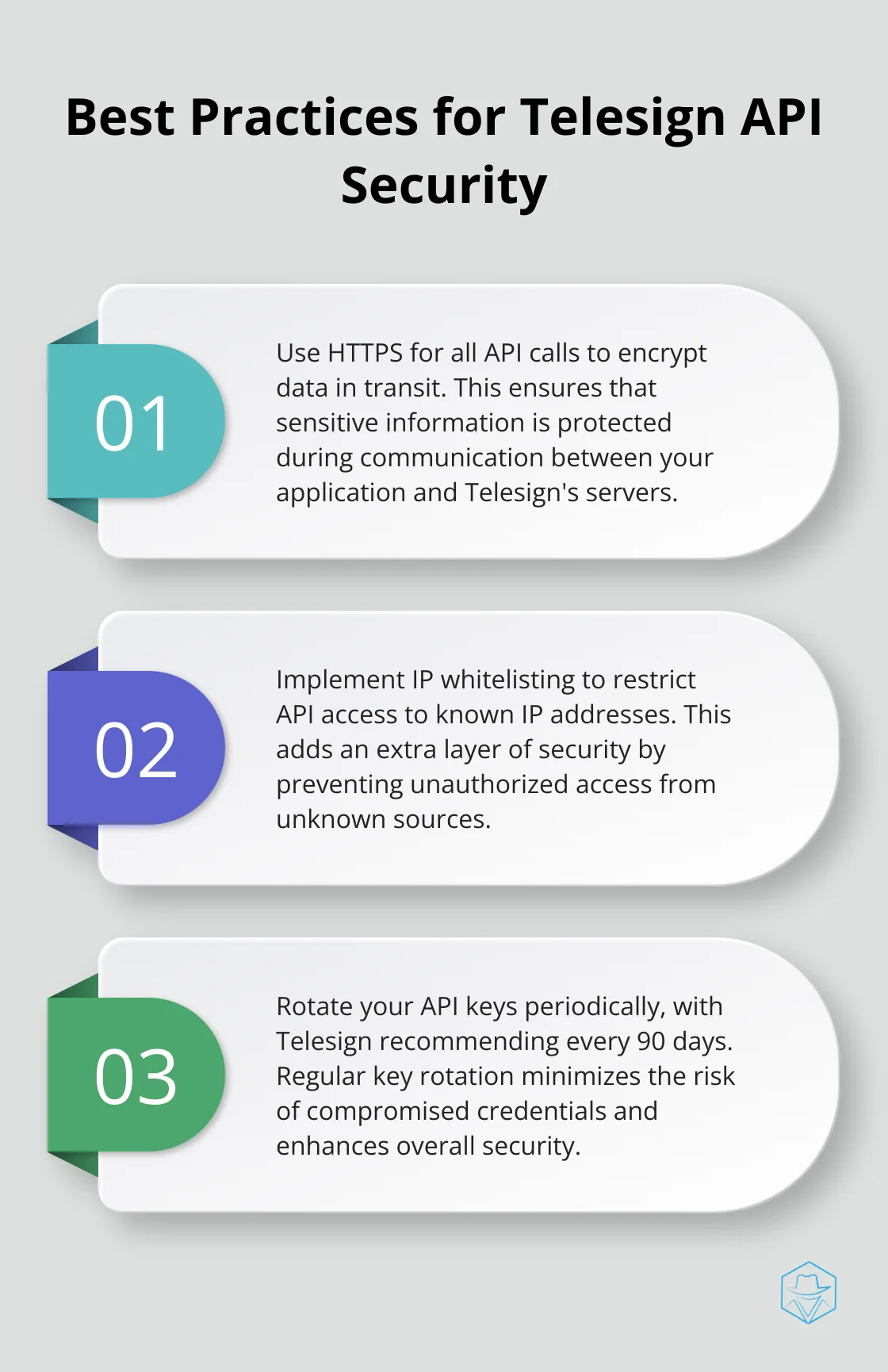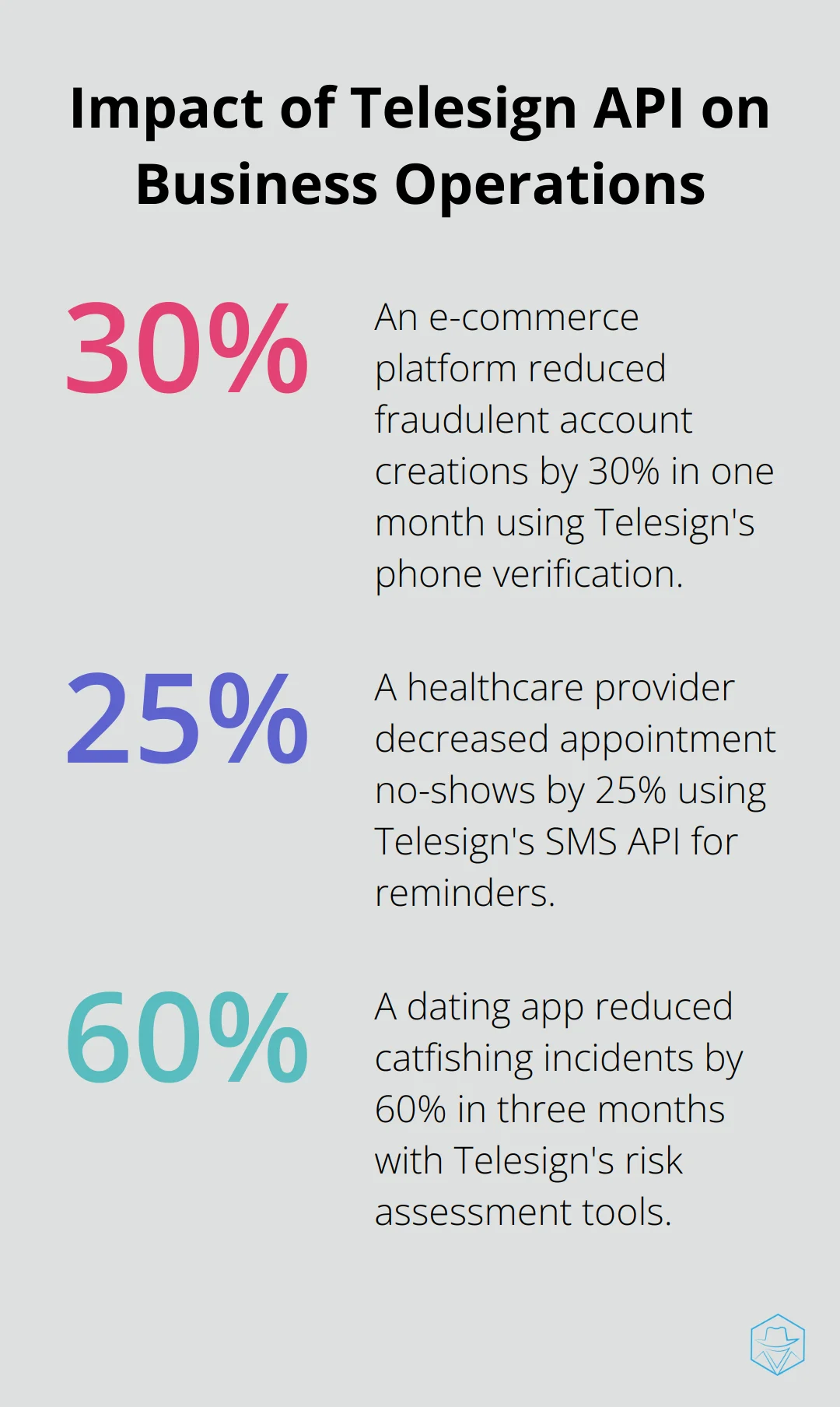Exploring Telesign API: Features and Integration Guide

At Drop Cowboy, we’re always exploring new ways to enhance communication and security for businesses. The Telesign API has caught our attention as a powerful tool for phone number verification, messaging, and fraud prevention.
In this post, we’ll dive into the features of the Telesign API and provide a comprehensive guide for integrating it into your applications. We’ll also explore real-world use cases and compare it with alternative solutions to help you make an informed decision for your business needs.
What Is Telesign API?
A Powerful Communication and Security Tool
Telesign API revolutionizes business-customer interactions. It offers phone number verification, SMS and voice messaging, and fraud prevention capabilities. These features enhance customer engagement and security measures for businesses.
Robust Verification and Authentication
Telesign API’s phone number verification system stands out. It verifies user identities quickly and securely, reducing fraud risk and improving account security. The API supports various verification methods (SMS, voice calls, and silent verification) for a frictionless user experience.
Global Messaging Capabilities
Telesign’s messaging capabilities impress with support for over 230 countries and territories. A network of 700+ direct-to-carrier operator routes ensures fast and reliable message delivery. The API supports both SMS and voice messaging, allowing businesses to choose the most effective communication channel.
Advanced Fraud Prevention
Telesign API incorporates advanced fraud prevention features. It uses machine learning and real-time data analysis to assess risks associated with phone numbers and user behaviors. This capability helps businesses prevent account takeovers, synthetic identity fraud, and other common security threats.
Developer-Friendly Integration
Telesign API caters to developers. It supports multiple programming languages (C#, Java, Node.js, PHP, Python, and Ruby). This wide language support enables development teams to integrate Telesign into existing systems without learning new programming languages.

The API includes comprehensive documentation and an API Explorer tool. Developers can test API calls without writing code, speeding up the integration process and helping them understand the API’s capabilities more quickly.
While Telesign API offers impressive features, Drop Cowboy provides similar capabilities with unique advantages. Our Mimic AI™ technology allows for voice cloning in ringless voicemail campaigns, a feature not offered by Telesign. Additionally, our Smart Delivery™ system ensures efficient global message delivery to over 80 countries.
Now that we understand Telesign API’s features, let’s explore how to integrate it into your application.
How to Integrate Telesign API
Setting Up Your Telesign Account
To start using Telesign API, you need to create an account. After signing up, Telesign will provide you with a unique Customer ID and API Key. These credentials authenticate your API requests, so keep them secure. Never expose these credentials in client-side code or public repositories.
Choosing Your Integration Method
Telesign offers two main integration methods: RESTful API and SDK. The RESTful API works with any programming language that can make HTTP requests. SDKs are available for popular languages (Python, Java, PHP, and Node.js), which simplify the integration process.
For most developers, using an SDK proves the quickest way to start. It handles many low-level details, allowing you to focus on implementing Telesign’s features in your application.
Implementing Core Features
After setting up your account and choosing your integration method, you can implement Telesign’s core features:
- Phone Number Verification: Use the Verify API to send one-time passcodes via SMS or voice call.
- SMS Messaging: Implement the Messaging API to send SMS messages to your users.
- Voice Calls: Use the Voice API for automated voice calls and notifications.
- Phone Number Intelligence: Use the PhoneID API to gather insights about phone numbers.
Best Practices for API Usage
To optimize your use of Telesign API, consider these best practices:
- Implement proper error handling. Telesign provides detailed error codes and messages. Use these to provide meaningful feedback to your users and to handle retries when necessary.
- Use webhooks for real-time updates. Instead of polling Telesign’s servers for status updates, configure webhooks to receive instant notifications about message delivery status and verification results.
- Implement rate limiting on your end. While Telesign has its own rate limits, implementing your own can prevent accidental API abuse and help manage costs.
- Use Telesign’s sandbox environment for testing. This allows you to simulate API calls without incurring charges or sending actual messages.
- Regularly update your SDK. Telesign frequently releases updates with bug fixes and new features. Staying up-to-date ensures you’re using the most efficient and secure version of the API.
Security Considerations
Security should be a top priority when integrating any API. With Telesign, you should:
- Use HTTPS for all API calls to encrypt data in transit.
- Implement IP whitelisting to restrict API access to known IP addresses.
- Rotate your API keys periodically (Telesign recommends every 90 days).
- Monitor your API usage for any unusual patterns that might indicate a security breach.

While Telesign offers robust features, it’s worth noting that Drop Cowboy provides similar capabilities with unique advantages. Our Mimic AI™ technology allows for voice cloning in ringless voicemail campaigns (a feature not offered by Telesign). Our Smart Delivery™ system ensures efficient global message delivery to over 80 countries. These features make Drop Cowboy a strong alternative for businesses looking for advanced communication solutions.
Now that we’ve covered the integration process, let’s explore some real-world applications of Telesign API in various industries.
How Telesign API Transforms Business Operations
Strengthening User Authentication
Telesign’s Verify API empowers businesses to implement robust phone number verification. When a user signs up for a service, the API sends a one-time passcode (OTP) to their phone. This additional step reduces the risk of fake accounts and enhances overall security.
A major e-commerce platform implemented Telesign’s phone verification and experienced a 30% reduction in fraudulent account creations within the first month. This improvement not only boosted security but also increased user trust in the platform.
Enhancing Customer Communication
Telesign’s SMS and voice messaging capabilities create new channels for customer engagement. Businesses can use these features for appointment reminders, order updates, or promotional messages.
A healthcare provider utilized Telesign’s SMS API to send appointment reminders and observed a 25% decrease in no-shows. This simple implementation saved the provider thousands of dollars in lost revenue and improved patient care.
For time-sensitive communications, voice messaging proves particularly effective. A financial services company employed Telesign’s Voice API to send fraud alerts to customers, resulting in a 40% faster response time compared to email notifications.
Mitigating Fraud Risks
Telesign’s fraud prevention and risk assessment tools help businesses protect themselves and their customers from various threats. The PhoneID API provides valuable insights about phone numbers, helping identify potential risks before they escalate into problems.
A dating app integrated Telesign’s risk assessment tools and succeeded in reducing catfishing incidents by 60% in just three months. This improvement not only enhanced user experience but also significantly reduced the workload on their customer support team.

Maximizing API Benefits
To maximize the benefits of Telesign API (or any communication API), businesses should focus on strategic implementation. The process starts with identifying the most critical pain points in current processes, then exploring how these API features can address them.
Careful planning and execution can transform business operations, enhance security, and improve customer satisfaction. Companies should try to implement proper error handling, use webhooks for real-time updates, and regularly update their SDK to ensure they’re using the most efficient and secure version of the API.
Considering Alternatives
While Telesign offers robust features, it’s important to consider alternatives. Drop Cowboy, for instance, provides similar capabilities with unique advantages. Our Mimic AI™ technology allows for voice cloning in ringless voicemail campaigns (a feature not offered by Telesign). Additionally, our Smart Delivery™ system ensures efficient global message delivery to over 80 countries, making Drop Cowboy a strong choice for businesses seeking advanced communication solutions.
Final Thoughts
The Telesign API offers powerful features for businesses to enhance communication and security. It supports over 230 countries, provides phone verification, and includes SMS and voice messaging capabilities. Developers appreciate its multi-language support and comprehensive documentation, which simplify the integration process.
Drop Cowboy presents a compelling alternative to the Telesign API with our advanced communication platform. We offer unique advantages such as Mimic AI™ technology for voice cloning in ringless voicemail campaigns. Our Smart Delivery™ system ensures efficient message delivery to over 80 countries, rivaling Telesign’s global reach.
Communication APIs will play an increasingly important role in digital transformation. Artificial intelligence and machine learning will likely enhance fraud detection and enable more personalized experiences. Businesses that implement robust communication APIs (like Telesign or Drop Cowboy) can significantly improve their operations and customer relationships in today’s digital landscape.
blog-dropcowboy-com
Related posts

June 27, 2025
Phone Dialer for PC: Streamline Your Communication
Streamline calls with a phone dialer for PC. Enhance communication efficiency and discover tools to optimize your business connections.

May 27, 2025
Do You Need a License for Wholesale Real Estate?
Explore if you need a real estate license to wholesale. Understand the regulations, benefits, and practical tips for wholesale real estate success.

June 27, 2025
PC Phone Dialer: Make Calls from Your Computer
Call easily from your computer with a PC phone dialer. Discover its benefits, streamline your communication, and enhance your productivity today.

June 23, 2025
Sinch Mailgun: Revolutionizing Email Delivery
Explore how Sinch Mailgun boosts email delivery, enhances open rates, and optimizes communication with cutting-edge tools for businesses.
September 3, 2025
Tracking the Success of Your Personalized Marketing Campaigns
Boost your marketing results! Discover effective personalized campaign tracking tips to measure and enhance your strategies’ performance.

July 20, 2025
Real Estate Marketing Automation: Close More Deals
Boost sales with real estate marketing automation. Discover tips, trends, and tools to enhance your lead generation and close more deals.